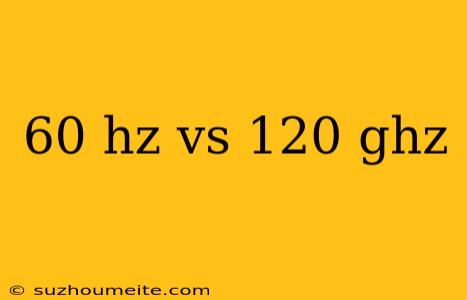60 Hz vs 120 Hz: What's the Difference?
When it comes to displays, refresh rate is an essential aspect that can greatly impact the viewing experience. Two common refresh rates found in modern displays are 60 Hz and 120 Hz. But what's the difference between them, and which one is better? Let's dive in and explore.
What is Refresh Rate?
Before we dive into the comparison, let's quickly discuss what refresh rate is. Refresh rate refers to the number of times a display updates the image on the screen per second. It's measured in Hertz (Hz) and is usually expressed in numbers such as 60 Hz, 120 Hz, or 240 Hz.
60 Hz Refresh Rate
A 60 Hz refresh rate is the standard for most displays, including TVs, monitors, and laptops. This means the display updates the image 60 times per second. This refresh rate is sufficient for general use, such as:
- Web browsing: You won't notice any lag or stuttering while scrolling through websites.
- Office work: 60 Hz is more than enough for tasks like word processing, email, and spreadsheets.
- Casual gaming: For casual gamers, 60 Hz is sufficient for playing games like Minecraft, Overwatch, or League of Legends.
However, 60 Hz may not be ideal for:
- Fast-paced gaming: Fast-paced games like first-person shooters or fighting games may exhibit screen tearing or stuttering.
- Video editing: Professionals may notice lag or stuttering when editing videos or working with graphics-intensive software.
120 Hz Refresh Rate
A 120 Hz refresh rate is typically found in gaming monitors and high-end TVs. This refresh rate updates the image 120 times per second, providing a smoother and more responsive experience. The benefits of 120 Hz include:
- Reduced screen tearing: Screen tearing is significantly reduced, making for a more immersive gaming experience.
- Improved motion clarity: Fast-paced content, such as sports or action movies, becomes more fluid and clearer.
- Enhanced responsiveness: 120 Hz provides a more responsive feel, making it ideal for fast-paced games and competitive gamers.
Comparison: 60 Hz vs 120 Hz
Here's a summary of the key differences between 60 Hz and 120 Hz refresh rates:
| | 60 Hz | 120 Hz | | --- | --- | --- | | Refresh Rate | 60 times per second | 120 times per second | | Gaming | Suitable for casual gaming | Ideal for fast-paced gaming | | Video Editing | May exhibit lag or stuttering | Provides a smoother experience | | Motion Clarity | May exhibit screen tearing | Improved motion clarity |
Conclusion
In conclusion, a 120 Hz refresh rate offers a smoother and more responsive experience compared to a 60 Hz refresh rate. While 60 Hz is sufficient for general use and casual gaming, 120 Hz is ideal for fast-paced gaming, video editing, and those who desire a more immersive experience. When choosing a display, consider your specific needs and whether a higher refresh rate is necessary for your activities.
